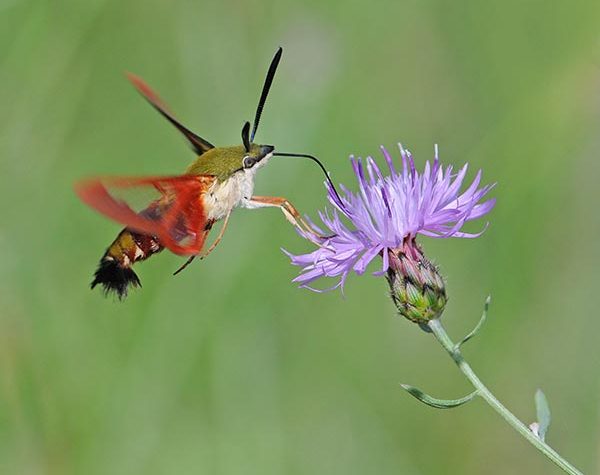The Hummingbird Moth: One of Canada’s coolest creatures
My in-laws have a bunch of hummingbird feeders in their yard. As the sun starts to set, you can stand on their deck to watch (and listen!) as the birds zoom around and then hover beside the feeders. It’s very, very cool. I don’t think I ever saw a Hummingbird in real life when I was a kid, so seeing one up close as an adult was almost magical. I’d never seen anything like it. I didn’t think there was anything like it…until I discovered the Hummingbird Moth.
If a bumblebee and a hummingbird had a magnificent baby, it would be the Hummingbird Moth. It looks like an enchanting critter plucked right out of a fairytale, with its tapered body and wings that flutter into a blur, so it is remarkably easy to mistake it for something (anything!) other than a moth.
Canada is home to the Hummingbird Clearwing Moth, whose upper back is normally covered in olive or tan hairs and whose lower back is decorated with reddish-brown bands, making them quite pretty. As the name suggests, its wings are clear (except for the veins and borders), but even with a wingspan of 4-6 centimetres, it’s hard to believe that they can keep their plump little bodies floating gracefully for so long. Lucky for us, this moth can be found across most of Canada from May through to July. They tend to live in open woodlands, gardens and meadows, and—like bumblebees—Hummingbird Moths act as pollinators in their ecosystems. They hover in front of a flower to drink its nectar with their long, unfurling tongues (just like their namesake), but some of the pollen that gets stuck to their upper body can still transfer to the flower.

I’ll admit it: I’ve never seen one in real life, at least as far as I know. I’ve been told that it’s almost startling to see one for the first time, as it’s practically impossible not to think “what is that?”, but then it quickly becomes an experience filled with awe and wonder.
Unlike most moths, Hummingbird Moths fly and feed during the daytime, so catching a sighting could be easier than you think. To increase your chances of having one visit your garden, grow a variety of plants native to your area—especially ones that the adults feed on, such as lilacs, beebalm, and thistles—and keep in mind that caterpillars may want to use leaf litter on the ground to build their cocoons for the winter. If you can, include some plants in your garden that the larvae like to eat, too—such as honeysuckle and hawthorns—so that you can accommodate these nifty critters throughout all their life stages.
This feels like my year. I think I’m going to see one. I certainly hope I’m going to see one, anyway, because I really do think that they’re one of Canada’s coolest creatures.



